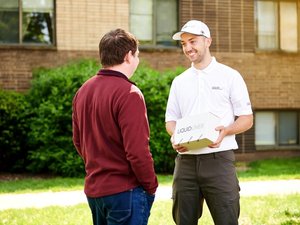
Tyler Dunagin, founder and president of Turnserv LLC in Akron, Ohio, says he stumbled on the idea for his company's first product — a bathtub refinishing system that offers a lifetime guarantee, emits no dangerous fumes and is easy enough to apply with hand tools.
But it was Dunagin's curiosity and collaboration skills that took the product, LiquidLiner, to market for his company's clients: owners and managers of multifamily buildings.
Turnserv gets its name from the practice of "turning over" an apartment — the process of cleaning, repairing and signing a new tenant for a unit that has been vacated. The turnover rate for multifamily units is around 50% per year, Dunagin says. So if an apartment complex has 500 units, 250 of those would need turnover services each year.
Dunagin began serving the multifamily market by developing a system for repainting units that are being turned over. That business is called ApartmentPainters.com, which is one of Turnserv's four brands/operating companies. The others are LiquidLiner.com; ApartmentFlooring.com, which installs apartment flooring products; and LoopMRO, an autonomous software system that apartment owners and managers use for scheduling, ordering, tracking, and managing their services and products.
In June, Turnserv landed an investment from Kaulig Capital, the private investment unit of Hudson-based Kaulig Cos., which is the single-member family office of entrepreneur and philanthropist Matt Kaulig. Though neither Dunagin nor Kaulig would specify the amount invested, Dunagin said Kaulig Capital took a 30% stake in his company.
Dunagin is using the capital to hire more workers and to expand geographically by opening 30 to 50 locations for his company's operating companies within the next four years.
Cleveland Business Journal talked with Dunagin about how he developed LiquidLiner.\
This interview has been edited for clarity and brevity.
How did you stumble on the idea for LiquidLiner?
At one property, I got a call from our lead technician [who] said, "Sorry, we can't service this unit today." I said, "What's going on?" So I get to the property, and I walk up to the unit, and as soon as I get in the hallway ... there's this potent smell. And so I put a mask on, and I went into the unit to see what [was] going on.
There was an air-mover machine with a long line draped out the window, blowing out ... fumes. The noise was so loud that you could barely hear yourself think. And I noticed the person in the bathroom was in a full-fledged hazmat ... suit. So I watched that person for about 10 minutes as they sprayed this bathtub and the shower surround.
I couldn't just drive home. I sat down in the hallway and I waited by the door with my mask on for about three hours because I just had to know what he was doing. [He's] refinishing the bathtub. And I said, "Hey, if I help you carry out all your equipment, can I ask you some questions?"
After experimenting with existing spray-on products, how did you develop LiquidLiner?
I partnered up with a lab partner and I took them six different products and said, "These are the biggest products in the market and they're all terrible. I need something that could outperform all of these." About a year of R&D later, we got our first batch back of what LiquidLiner products would be.
It's a two-part epoxy. [But] you don't need any ... spraying equipment. [There is] none of the loud noisiness, none of the smells, no hazmat suit ... because there are no [volatile organic compounds being emitted]. It fits into a small box and you're able to apply it with simple hand tools. To top it all off, our product is 30 times thicker than almost all spray-on applications, so it's going to outlast anything on the market today. In three hours, I can teach you how to do a bathtub routinely, professionally.
We had it third-party tested [against products currently on the market], and on a scale of [one to] 10, LiquidLiner was a 10 out of 10 across the board. The next closest manufacturer was a six out of 10. [So] LiquidLiner definitely has gotten a lot of attention lately. We [own] the product and we own the service and it really does improve the lives of our customers. It's our product outright and we "license" it or sell it to our service companies.
So, what's next for you?
I'm going to stay focused on my team ... instead of being in straight discovery and exploratory mode. I'm focused on our team, our psychology, our culture. That's my main focus. My secondary focus is improving operations as much as possible, but more than that, getting us into different markets.
We're [also] talking with another private equity company about [investing in] just our products. I am ... creative. I enjoy building things. I enjoy developing things. I just have a curious mind. And ... I've been working on ... [a couple of] additional products.
There's another iteration [of LiquidLiner] that we're working on for cabinetry right now and countertops. And I'm also developing a cleaning agent ... that pairs well with our refinish surfaces that we could sell to our customers. A safe product that does a good job.
Sign up for the Business Journal’s free daily newsletter to receive the latest business news impacting Cleveland.







